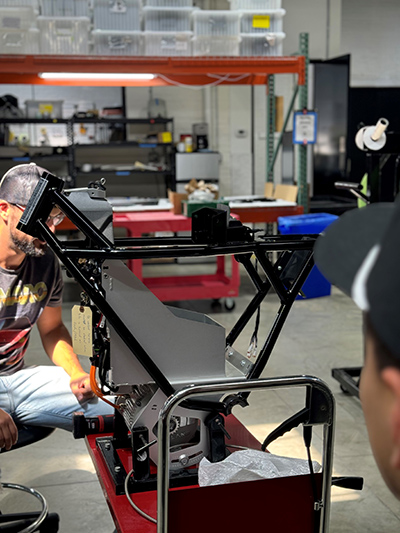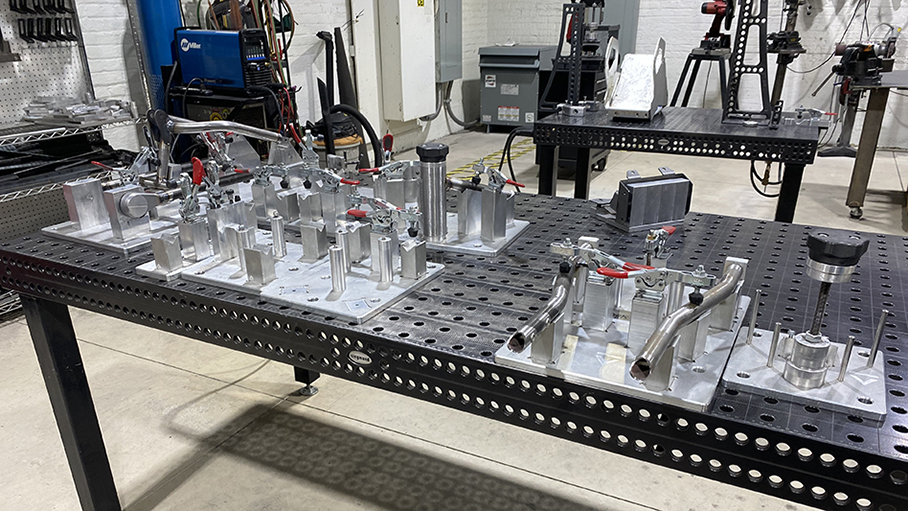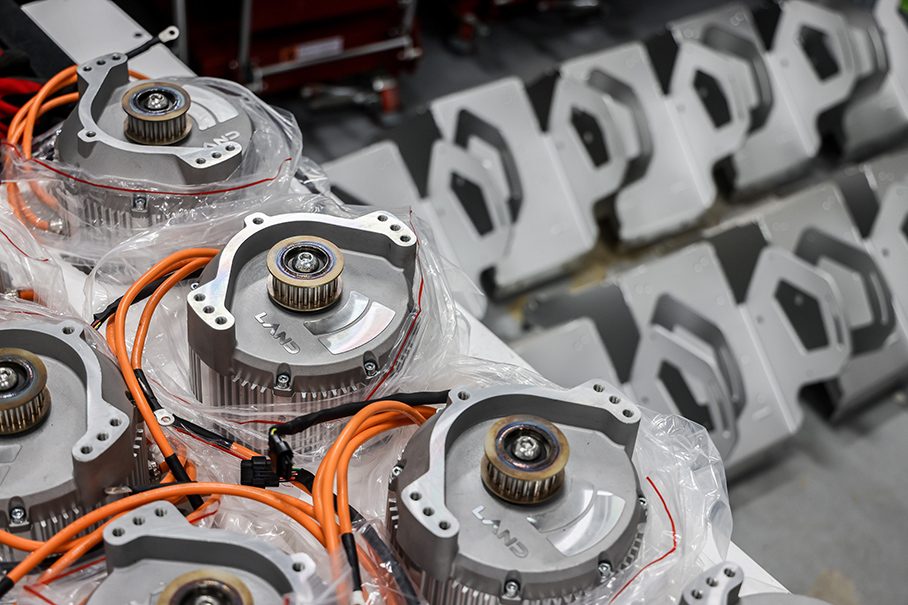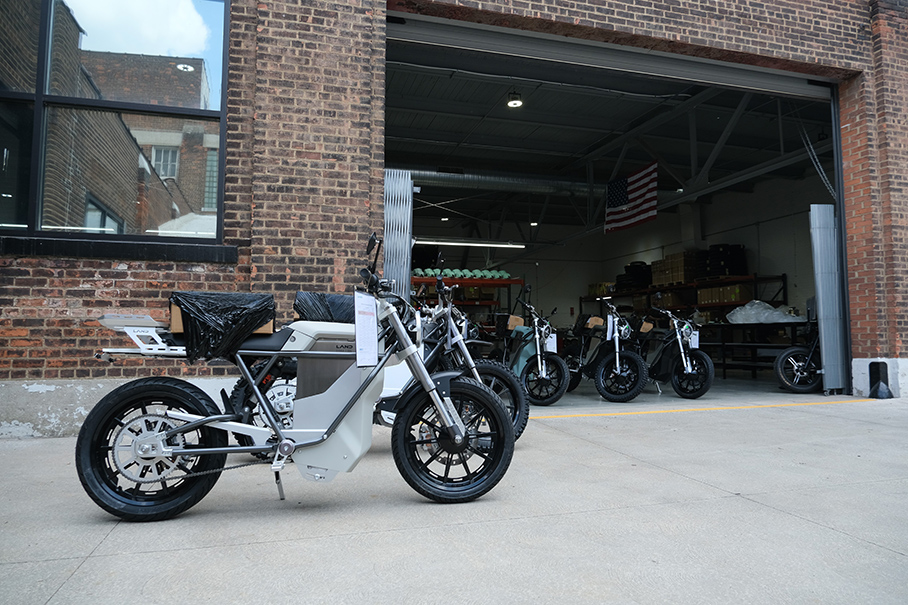
CREDIT: CLARE SCOTT, GIE MEDIA
The year 2020 will likely be remembered most as the year the world shut down. As the COVID-19 pandemic roared across the globe, businesses and schools closed, city streets grew quiet, and many people suddenly found themselves stuck in their homes with a lot of time on their hands. Some binged TV shows, while others learned how to bake bread – and some, like LAND Energy Founder and CEO Scott Colosimo, launched startups.

At first glance, you could hardly find a worse time to launch a business than March 20, 2020, but the Cleveland, Ohio-based electric motorcycle manufacturer took advantage of the downtime to research, develop, and hone its product, resulting in the District e-moto, a sleek, speedy electric two-wheeler that can be ridden as an e-bike, e-moped, or e-motorcycle, depending on the mode the rider chooses. The District currently offers a range up to 120 miles and speeds topping 70mph.
Currently offered in two street-legal versions, the urban Street and the off-road-capable Scrambler, the District has been drawing attention in the electric motorcycle world, but the company’s name is LAND Energy, after all, and that’s really where its attention is focused – on creating a versatile, off-grid energy source that can power more than just electric vehicles (EVs).

“As far as it being LAND Energy and not LAND Moto, it’s a tale of supply chain,” says Henry Remington, head of engineering at LAND. “We were working with a number of suppliers to provide us with the battery platform and the motor controller and all of that, and it ended up falling through. So we ended up designing it ourselves. We went out and learned a lot about EVs, batteries, cells, and packaging for making our own battery packs. We decided there’s definitely a bigger future in being more energy focused, and not just electric motorcycles.”
The CORE of LAND Energy
That exploration led to the development of the smart, swappable CORE battery. While swappable battery technology tried and failed to get off the ground in the United States about a decade ago, it’s beginning to make a comeback as more drivers explore the possibility of EVs but remain apprehensive about an often-unreliable charging infrastructure. Swappable batteries such as the CORE module can be used in pairs, one powering the vehicle and the other held in reserve to pop into place once the first one gets drained. The first one can then be charged, and the cycle continues. It’s a lot easier to charge a battery than a full vehicle, especially if you live somewhere without easy access to EV charging stations.
Ease of use is a priority in the design of CORE, which LAND Energy describes as a human-scale battery – a term the company coined for the product it developed to fill the gap between smaller, lower-power backup batteries and larger, more complex EV batteries.
“We developed a battery pack with the power output of something that is more locomotive, so something that can move a motorcycle, but in the scale of something that someone can move and access as a human,” Remington explains. “We like to think of our batteries as performance batteries that can power your daily lives, but in the size, in the form factor, that you can actually move yourself as a person.”

A CORE battery produces up to 14.4kW, more than a NEMA 14-50 plug. Its portability means it can be easily taken out of a bike and used for anything from cell phone charging to backup power to a small car, four-wheeler, or other small vehicle. According to Remington, LAND has been approached by companies interested in using its battery technology for applications including water filtration, power backup for disaster relief, and others.
“Everybody's talking about vehicle-to-grid,” he says. “What we wanted to provide is a more granular approach to that, in situations where you need to place batteries at specific locations. Since we have a power output that’s even more than a Tesla Powerwall, the power generation we can provide at a specific location is pretty vast.”
Another factor setting the CORE model apart is its cloud connectivity. Its Internet of Things (IoT) functionality allows the user and the LAND team to monitor the health and performance of the battery, and enables LAND to collect data they can use to improve future products. The user can connect to the bike itself through a smartphone app and receive ride data including speed, distance, GPS, etc., and can use the app to lock their bike’s drivetrain and track its location for security purposes. The battery can also be upgraded when new features become available, sidestepping the rapid obsolescence that plagues so much other tech.

Scaling up, moving forward
Remington believes EV batteries have gotten a bad rap, especially when it comes to safety, but the technology has improved immensely over the last decade and continues to improve. While disastrous battery fires continue to make headlines, especially with the recent uptick in combustion incidents caused by hurricane flooding, EV batteries remain less likely to catch fire than gas engines. Still, further improving safety, as well as public perception, should be a priority for the EV battery manufacturing industry, Remington says. He points to less volatile materials and standardized cell sizes as examples of goals for reducing risk and cost in the future.
While the CORE batteries used to be manufactured overseas, LAND is bringing that manufacturing in-house in 2025 and has hired additional employees for that purpose. The company is very firm in its goal of producing as much as possible domestically as well as locally, and it’s been sticking to that goal admirably, with most of its research, development, and manufacturing taking place at its Cleveland facility. LAND doesn’t hesitate to embrace automation; as its production numbers have increased, it’s recently begun using robotic welding for its subassemblies. And the numbers are increasing fast – the company has been seeing a great deal of demand and is currently working to raise money to produce more bikes and expand into B2B battery sales.
“A lot of people want to work with us,” Remington says. “They like our technology, but we have to be able to support their purchasing if we want to work with any sort of big box. We’re trying to move from medium- to high-volume manufacturing. We have the tech, we have the development. We're just ready to move.”

Latest from EV Design & Manufacturing
- Electric for All aims to educate consumers about electric vehicles
- Registration is open for April’s Manufacturing Lunch + Learn!
- Nuvve offers Battery-as-a-Service solution
- Aerospace Industry Outlook webinar is back by popular demand
- Automation Webinar with Visual Components
- Rivian announces new micromobility spin-off
- Lynkwell’s automated onboarding solution speeds EV charger installation
- Partnership to explore solutions for urban logistics fleet electrification







